AMD's 65nm Brisbane Core Previewed: The most energy efficient AMD CPU to date
by Anand Lal Shimpi on December 14, 2006 6:08 PM EST- Posted in
- CPUs
Media Encoding Performance & Power Consumption - Continued
Our final two encoding tests are, as always, Quicktime for testing H.264 encode performance and iTunes for testing multi-threaded MP3 encode performance.
Quicktime paints the same picture we've seen with WME and DivX, so there are no surprises here:
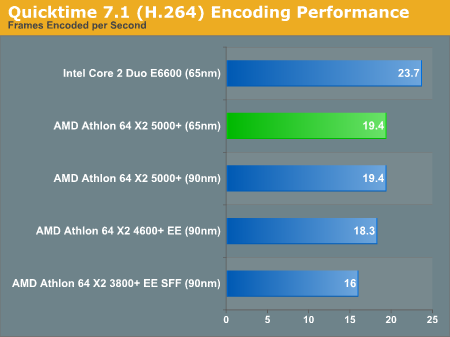
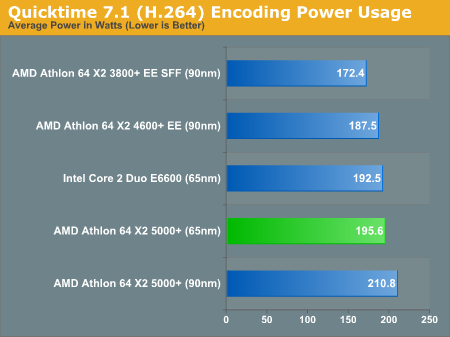
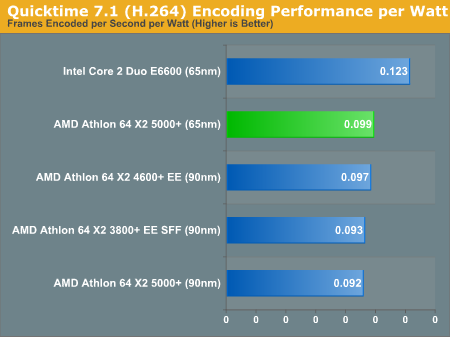
Rounding out our encoding tests we have similar standings with our iTunes performance test:

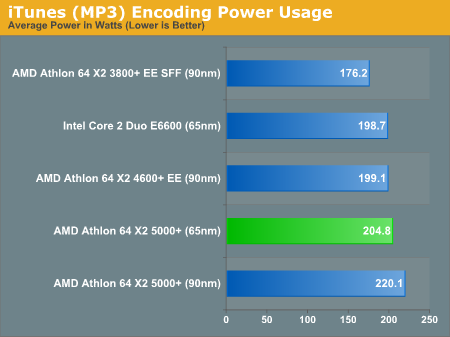
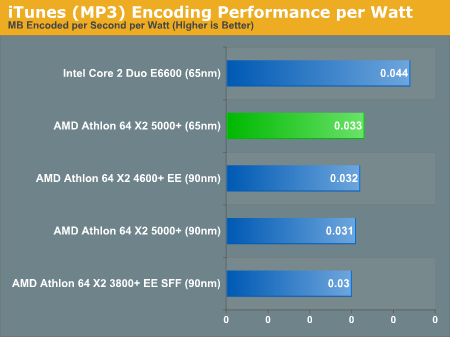
Power consumption is a bit lower on 65nm, but Intel still has a bit of a power advantage here with the E6600.
Performance per watt of course goes to Intel, not necessarily due to advantages in power consumption but rather the inherent performance advantage of the Core architecture.










63 Comments
View All Comments
mino - Friday, December 15, 2006 - link
Read some paper on entropy.The problem in this discussion is most participants do not know what heat, electricity, work(i.e. in joule), work(i.e. inlogical one) means.
Except for electromagnetic waves that leak badly shielded PC and the energy required to transfer the information out of the PC (by monitor and network cables) the energy(in form of electricity) consumed by the CP is completely changed to heat.
In other words "focused" form of energy witch low entropy(electricity) is distributed to the environment and becomes an "unfocused" form of enegry, mostly heat. Also even the heat dispersed to the room is still partly focused in sense it still not spread to the whole universe.
Hope this clears it for some.
mino - Friday, December 15, 2006 - link
CP == PCsmitty3268 - Thursday, December 14, 2006 - link
I don't particularly know how transistors work (only the basics) but if a space heater isn't 100% efficient then why would a cpu be?Again, I could be wrong, but do you have any 3rd party info to support your claim?
Missing Ghost - Thursday, December 14, 2006 - link
I think space heaters are 100% efficient, except maybe if there is a fan, then it could be 99.999%.smitty3268 - Thursday, December 14, 2006 - link
If you can see something glowing, then at least part of the energy is producing visible light and not heat. Although now that you mention it, I think I heard that plain old light bulbs are fairly efficient heaters.smitty3268 - Thursday, December 14, 2006 - link
From http://www.intel.com/technology/silicon/si11031.ht...">http://www.intel.com/technology/silicon/si11031.ht...This implies what I was saying, but perhaps the devices only run cooler because they require less power to begin with?
JarredWalton - Thursday, December 14, 2006 - link
Heat density: less power in a smaller area can potentially run hotter (witness Prescott vs. Northwood P4). Except we're seeing the reverse here, so probably it's just a difference in chip/package design. There's no guarantee that the various chips are measured identically, meaning AMD could have changed temperature reporting with 65nm, and certainly the AMD vs. Intel numbers are not a direct comparison. I would put more weight on power numbers, personally.eRacer - Wednesday, December 20, 2006 - link
In future Brisbane reviews could you check the Brisbane idle temperature to see if it appears to be somewhat accurate? Other previews and leaks show Brisbane idle temperatures in the 10C-15C range which is well below room temperature. Idle and load temps of Brisbane may actually be 15C higher than what is reported.Stereodude - Thursday, December 14, 2006 - link
I was excluding the C2D from my comments. Sorry if that wasn't clear.If anything the die shrink should make the Brisbane run slightly hotter since the die is a little smaller. I can't come up with any good reason why one 65W processor runs cooler than another 65W processor given the same cooler and same size heat spreader. Maybe the heatspreaders aren't flat between all the AMD CPUs. The 35W AM2 processor definitely should have run cooler.
eRacer - Thursday, December 14, 2006 - link
"As you can expect, AMD is pricing the 65nm chips in line with its 90nm offerings to encourage the transition. Die size and TDP have both gone down to 147 mm^2 and 65W across the line.Is 147 mm^2 accurate? That happens to be the same die size of 90-nm A64 X2 Manchester, and isn't much of a shrink from the current 183mm^2 512KBx2 Windsor cores. Some rumors had put it at ~125 mm^2.